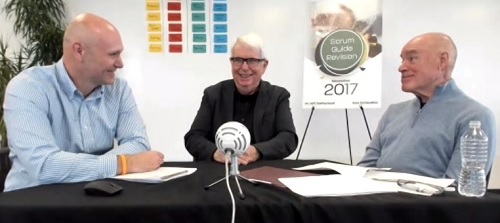Hey guys!
Yesterday I attended a very interesting event that is important for any Scrum practitioner. The Scrum creators (or “Parents of Scrum” as they call themselves) Ken Schwaber and Jeff Sutherland announced changes in the Scrum Guide. The changes are focused on responses to input from Scrum users. If you have any ideas how Scrum can be improved, you can share it here and maybe it will be included into the next Scrum Guide revision!
In 2016 the changes were relatively small. Just a new short “Scrum Values” section was added. This year changes are bigger. There is also a new section devoted to the uses of Scrum and some changes in four other sections.
Let’s go over every change:
Uses of Scrum
This is a new section. Scrum started as a framework for software development. However, over the years it became obvious that Scrum can be used in many areas. Jeff told, for example, now he is teaching Scrum to people who drill wells and extract oil. So the new section gives many examples of industries and areas where Scrum is being successfully used.
The Role of the Scrum Master
Now the Scrum Master is officially responsible for promoting and supporting Scrum across the organization. From my side I would say that I have been always thinking about the Scrum Master role in this way. As I understand this change is about better phrasing only.
The Daily Scrum
The gurus told that the Daily Scrum is one of the most misinterpreted Scrum Events. Usually people just gather together and report their status. It is not enough.
The Daily Scrum is for Inspection and Adaptation to ensure progress is being made toward the Sprint Goal.
Another important point is that now there is no predefined meeting format like answering questions. It can be conducted in different ways. For example, it can be discussion based or “walking the board”. The only requirement is the meeting should be focused on progress toward the Sprint Goal.
Time-Boxes Only Require a Maximum Length
This item is self explanatory. Earlier many people thought an event should always take all the prescribed time. Actually many Scrum teams are so effective that could manage events many times faster. Now the guide is very clear on this point.
Retrospective Action Items in the Sprint Backlog
This also is pretty straightforward. Now the Sprint Backlog should include at least one process improvement item identified at the previous Retrospective.
From my side I would add that we always have been acting in this way.
Q&A about Scrum
There were several questions and answers about Scrum from the Gurus:
Is Scrum Only Relevant to Software Delivery?
No. We build successful products. Software is only part of the equation. The Product Backlog has dimensions for:
- Development
- Bug fixing and technical debt remediation
- Operational environment development
- Marketing
- Training and readiness
- Pilot markets and early releases
- …
Can I Release Before the End of the Sprint?
Releases may be delivered at any time. The only requirement is to have “Done” increment at the end of the Sprint.
Continuous Delivery can be used with Scrum.
What about DevOps?
The Development Team should prove within the first several Sprints that the Product is viable and will produce value. To do this the team should decide on the initial architecture and create an operational environment.
Sooner or later the new changes will go into PSM and PSPO exams. So, I will update my quizzes to reflect it.
See you later!

